Mastering Home Composting: Step-by-Step Guide
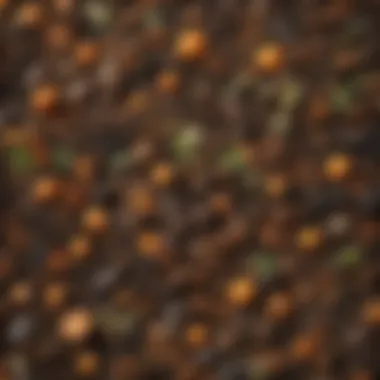
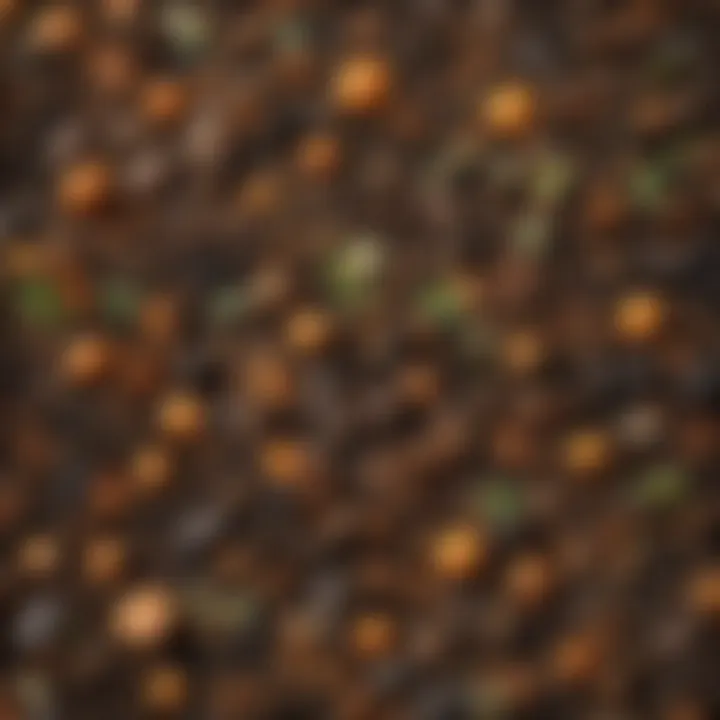
Intro
Composting at home is more than just throwing scraps into a bin. It’s about creating a thriving ecosystem right in your backyard. Think of it as nature’s recycling program: you take what you would normally discard and turn it into something beneficial. In a world where waste management is increasingly important, nurturing this process at home holds significant value. It reduces landfill waste and creates nutrient-rich soil that can support gardens and plants.
The beauty of composting lies in its simplicity, yet it also involves a layer of science. It’s not just about the items you toss into the pile but understanding the conditions that foster decom posers, like bacteria and fungi. Most people think it’s just a pile of leaves and food scraps. But it’s a delicate balance of greens (nitrogen-rich materials) and browns (carbon-rich materials).
As we delve into composting, we’ll cover the essential steps for setting up and maintaining your system, offer guidance on selecting the right materials, and look into types of compost bins that fit your needs. Additionally, this guide will act as a mentor, addressing common troubles and best practices to ensure your composting journey is fruitful.
Let’s uncover the nuts and bolts of transforming waste into a garden powerhouse.
Understanding Composting
Composting isn't just a trend; it's a vital practice that connects us with the ecosystem in a way we often overlook. It transforms the mundane waste of our kitchens and gardens into a resource that benefits our environment and enhances our gardens. Understanding composting means understanding how the natural cycle of matter works. The interplay between organic materials, microorganisms, and environmental factors results in rich soil that can feed our plants and nourish the earth.
At a grassroots level, composting reduces landfill waste. According to some estimates, food waste constitutes about 30-40% of the waste in landfills. By composting, individuals not only curtail this waste but also contribute to a more sustainable model of living. Moreover, composting at home empowers you to take control of how you manage waste, leading to a more self-sufficient lifestyle.
"Composting is nature's recycling."
This quote rings true as it emphasizes the cyclical nature of composting. It's nature’s way of breaking down organic matter to replenish the soil.
The Science Behind Composting
Composting is rooted in biology. It's the process where organic materials decay through the work of microorganisms, fungi, and larger decomposers such as worms. This team of nature's recyclers breaks down materials like fruit peels, grass clippings, and leaves, transforming them into compost – a darker, crumbly substance that is the hallmark of healthy soil.
The decomposition process involves several stages:
- Mesophilic stage: This initial stage spans several days to weeks. In it, bacteria begin to break down the organic material, causing a slight increase in temperature.
- Thermophilic stage: As temperatures soar, heat-loving bacteria take over. This phase helps to kill off pathogens and weed seeds, rendering the compost safer for garden use.
- Cooling and Curing: The material gradually cools, allowing for maturation. This period often goes unnoticed but is essential for developing nutrient-rich compost.
Understanding these stages underscores why maintaining the right balance of materials—greens and browns—is critical. Too much nitrogen will push the compost into the thermophilic stage too soon, while too much carbon will slow down the process.
Benefits of Composting at Home
The advantages of composting at home extend beyond simply creating nutrient-rich soil. These benefits can be summarized as follows:
- Environmental Impact: Reducing the carbon footprint by diverting kitchen and garden waste from landfills.
- Cost-Effectiveness: Saving money on commercial fertilizers and contributing to organic gardening practices.
- Soil Health: Compost adds essential nutrients, improves soil structure, and helps retain moisture, creating a more hospitable environment for plants.
- Biodiversity: Enhancing your garden's ecosystem by fostering a diverse array of organisms that thrive on compost.
- Personal Satisfaction: Engaging in composting can also be rewarding. Many find joy in nurturing their gardens and contributing to a positive environmental impact.
In sum, grasping the nuances of composting not only enhances our gardening efforts but also connects us more deeply with our local ecosystems. It's not just about recycling organic matter; it’s about fostering a more sustainable life, one compost bin at a time.
Selecting Your Composting Method
Choosing the right composting method is like picking the right tool for the job; it can make all the difference between a successful venture and a strenuous chore. Each method has its unique benefits, challenges, and suitability based on your living situation, the volume of waste generated, and even your gardening ambitions.
Your composting method should reflect your lifestyle, space, and how much time you're willing to invest. Understanding the available approaches can empower you to turn organic waste into rich compost more effectively, ultimately benefiting both your garden and the environment. Let's explore a few prominent methods that can sharpen your composting skills and enhance your gardening practices.
Traditional Compost Piles vs. Bins
When it comes to composting, you might find yourself weighing the options between a traditional compost pile or a designated compost bin. A traditional compost pile is typically a heap of organic material placed directly on the ground. This method works wonders for those with ample space and a regular supply of green and brown materials.
- Advantages of Traditional Piles:
- Minimal setup cost; just toss your scraps into a heap.
- Easier to manage larger volumes.
- Encourages faster decomposition through airflow.
However, if you're short on space or want a more contained setup, compost bins could be your answer. These bins often come with lids and can be made from various materials like wood, plastic, or even wire mesh.
- Benefits of Compost Bins:
- They take up less space and can fit in small yards or patios.
- Keep pests out and reduce odors.
- Maintain moisture and heat levels better compared to a pile.
The choice between pile and bin boils down to your personal circumstances. Each method requires some attention to balance greens and browns, aeration, and moisture.
Worm Composting: Vermiculture Basics
Don’t underestimate the power of worms; they are nature’s little recycling machines. Worm composting, more formally known as vermiculture, utilizes specific worm species, like red wigglers, to break down organic waste into nutrient-rich compost known as worm castings. This method is excellent for apartment dwellers or those with minimal outdoor space.
Setting Up Worm Composting:
- Container: Start with a bin that has drainage holes at the bottom to prevent overwatering.
- Bedding: Fill the bottom with shredded paper or coconut coir to provide bedding.
- Worms: Add the worms and introduce kitchen scraps, avoiding any meat or dairy products.
- Maintenance: Keep the bin in a dark, moisture-controlled environment, stirring it occasionally to ensure aeration.
The finished product is dark, crumbly, and smells pleasantly earthy—a gardener’s delight. It’s nutrient-dense and can rejuvenate tired garden soil or be used as a top dress for potted plants.
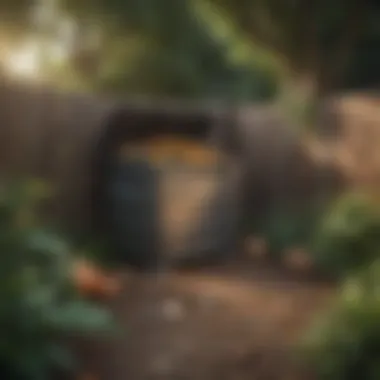
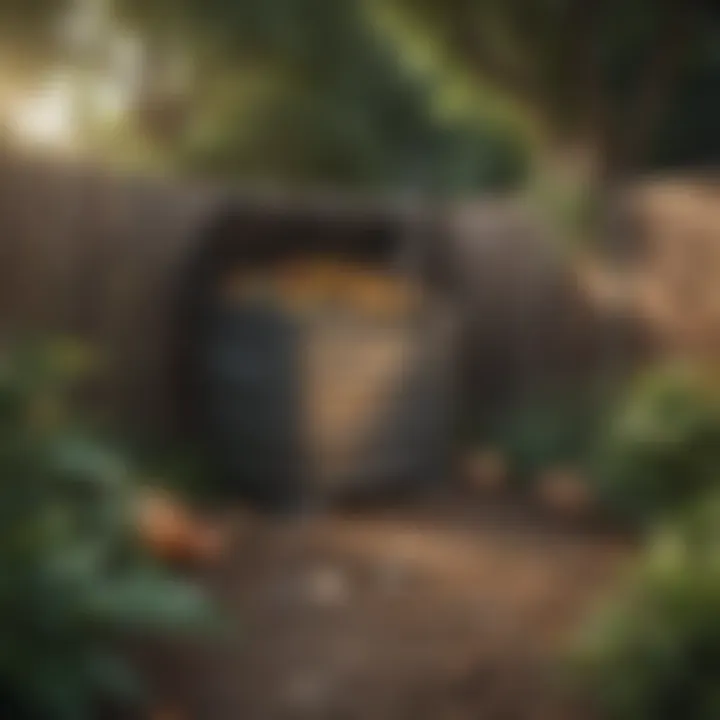
Bokashi: Fermentation Composting
Bokashi stands out as a unique method that employs fermentation to break down kitchen waste. The process utilizes a Bokashi bin and special inoculated bran to create an anaerobic environment that ferments rather than decomposes waste. This method can handle a broader range of materials, including meat and dairy, which aren’t typically suited to other composting systems.
How to Get Started with Bokashi:
- Bin Setup: Use a sealed container to prevent air from entering, which facilitates anaerobic fermentation.
- Layering: Alternate layers of food scraps with layers of Bokashi bran for effective fermentation.
- Fermentation Time: Close up the bin and let it sit for about two weeks; you’ll notice an acidic smell, indicating the process is working.
Once fermentation is complete, you can bury the Bokashi mixture in your garden soil, where microorganisms will complete the decomposition, enriching the soil over time. It’s an efficient option, promoting rapid nutrient cycling and bolstering soil biodiversity.
In summary, selecting a composting method tailored to your lifestyle is crucial. Whether you prefer the simplicity of a compost pile, the efficiency of worms, or the uniqueness of Bokashi, each approach offers a viable pathway to sustainable waste management and enriched gardening. By making an informed choice, you're halfway to becoming a proficient composter.
Choosing the Right Location
When embarking on your composting journey, the location of your compost bin or pile is pivotal. Choosing the right spot not only determines the ease of compost access but also impacts the efficacy of the composting process. A well-placed compost system can significantly enhance decomposition rates while minimizing potential nuisances associated with odors or pests. Here’s a closer look at the key considerations when selecting your composting location.
Evaluating Space in Your Yard
Before diving headfirst into composting, take a moment to survey your yard. Considerations will vary based on your available space, but some guidelines can make this assessment easier. Ideally, you want a flat area that is free from overhead obstructions to avoid unnecessary shade. Too much sun can dry out the compost too quickly, while excessive shade can slow down the decomposition process.
Keep an eye out for nearby structures or dense vegetation; a spot that’s too close to buildings can trap heat and moisture, creating unfavorable conditions. It's also important to take into account how close the compost bin will be to your home. A balance of convenience and functionality is crucial: too far away and you'll neglect it, too close and you may face aromatic surprises. Moreover, think about future expansions—if you’re on a composting trajectory, you might want to designate enough space for future growth in your composting activities.
- Key Points to Note:
- Select a level area with good drainage.
- Keep it at a comfortable distance from your house, but easily accessible.
- Allow room for potential future expansion.
Consideration of Sunlight and Drainage
Every seasoned gardener knows that sunlight and drainage are non-negotiable elements in successful planting—this holds true for composting as well. Sun hits your compost pile or bin, it heats up the materials inside, speeding up the breakdown process. Yet, while a touch of warmth can be beneficial, direct sunlight for prolonged periods can also cause the pile to dry out, which is not ideal.
Aim for a balance of sun and shade. Early morning sun is perfect to warm up your compost without it scorching it by noon. As for drainage, stagnant water can be detrimental, leading to foul odors and creating a hostile environment for the organisms that do most of the heavy lifting in decomposition. An area with natural drainage or slight elevation is ideal to prevent water pooling.
In essence:
- Aim for partial sunlight. It helps in maintaining the right temps.
- Look for good drainage, preventing excess moisture buildup.
"A well-chosen composting location makes the difference; it’s the unsung hero of a successful compost system."
What to Compost
Composting is more than just tossing scraps into a bin; it’s a strategic method of recycling organic waste into something beneficial. Understanding what to compost is fundamental for creating rich, nutrient-dense compost that can transform your garden and contribute to a sustainable ecosystem. Every ingredient plays a role, and knowing the right mix can make all the difference.
Green Materials vs. Brown Materials
In the composting world, not all materials are created equal. You generally categorize compostable items into two groups: green materials and brown materials.
- Green Materials: These are often fresh and moist items, packed with nitrogen. Examples include:
- Fruit and vegetable scraps
- Coffee grounds and tea bags
- Grass clippings
- Eggshells
Green materials kickstart the decomposition process, providing essential nutrients that help microorganisms thrive. However, relying solely on greens can lead to a smelly pile due to excess nitrogen.
- Brown Materials: In contrast, brown materials are dry and rich in carbon. They include:
- Dry leaves
- Twigs and small branches
- Shredded cardboard and paper
- Straw
These materials balance the green ones, absorbing excess moisture and preventing odor. Achieving a good mix—often called the carbon to nitrogen ratio—is crucial for effective composting. Aim for about two parts browns to one part greens for optimal results.
Effective composting requires a balanced mix of greens and browns to support microbial activity and improve the quality of the compost produced.
Avoiding Common Contaminants
While composting, it’s equally important to know what not to toss in the bin. Avoiding common contaminants is essential for a healthy composting process and environment. Certain materials can harm not only the compost but also the soil and plants:
- Meat and Dairy Products: These items can attract pests like rodents and produce foul odors. Stick to plant-based scraps.
- Oils and Grease: Adding fats can slow down decomposition and create a hostile environment for beneficial microorganisms.
- Weeds and Diseased Plants: If not composted properly, they can propagate in your garden later on. Always ensure that your compost is hot enough to kill pathogens and seeds.
- Synthetic Materials: This includes anything made from plastic or treated with chemicals. These will not break down and can leach harmful substances into your compost.
By keeping your compost bin clean and only adding appropriate materials, you will enhance the efficiency of the decomposition process and produce a higher quality compost. This will not only benefit your garden but also contribute positively to the environment.
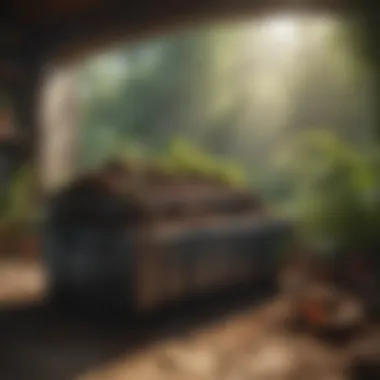
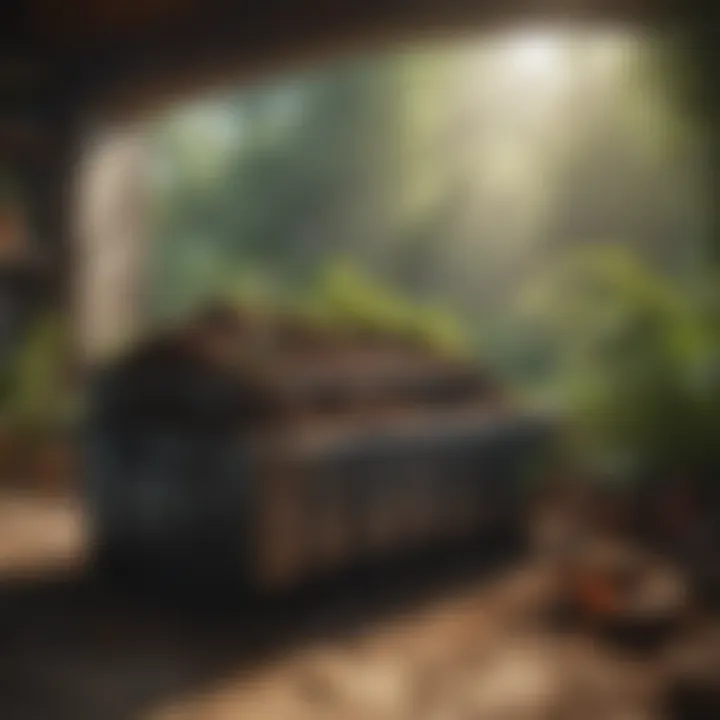
In summary, understanding what to compost is vital for any home composter. Recognizing the difference between green and brown materials, as well as avoiding contaminants, ensures a smooth composting process. The result? A satisfying pile of organic matter that can enrich your garden and reduce waste effectively.
Setting Up Your Compost Bin
Setting up a compost bin is a crucial first step in the journey of composting at home. This process is not just about creating a container; it’s about laying the groundwork for a sustainable practice that benefits your garden, reduces waste, and contributes to a healthier planet. The choice of compost bin—whether homemade or store-bought—can significantly influence how efficiently your compost breaks down.
Building Your Own Compost Bin
Building your own compost bin can be a rewarding project that allows you to customize its size and design based on your specific needs. It can also save you some money and give you a sense of accomplishment.
Materials Needed:
- Wooden pallets or wire fencing
- Hinges or latches (if you want a closed bin)
- Bailing twine or heavy-duty zip ties
- Tools: saw, drill, hammer, and screws
To start, choose a spot in your yard that is convenient to access yet has some shade to help maintain moisture. Make a simple frame out of wooden pallets, securing them with screws for sturdiness. If you prefer a rotatable bin design (which helps speed up the composting process), create a drum-style bin with a latch. This method makes it easy to aerate the compost by turning it regularly.
Feeling creative? You could even paint or decorate your bin to match your garden decor, adding a personal touch that could become a conversational piece among visitors.
Choosing Store-Bought Options
If DIY isn't your style, numerous store-bought compost bins can fit various budgets and aesthetics. Some popular options include:
- Tumbling Composters: Ideal for those who want a hassle-free option. They make aerating and mixing easier, making the composting process quicker.
- Worm Bins: If you're interested in vermiculture, these bins come designed specifically for housing worms.
- Stationary Bins: Many are made from recycled materials and come in various sizes, suitable for small or large yards.
When selecting a store-bought option, you might want to consider several factors:
- Size: Ensure it fits your yard space and meets your composting needs. If your household generates a lot of organic waste, a larger bin will be necessary.
- Material: Look for bins made from durable, weather-resistant materials that can withstand the elements.
- Ease of use: A bin that’s easy to access from the top or side can make adding materials simpler and keep you engaged in the composting process.
"Setting up the right compost bin can turn your organic waste into black gold, enriching your garden soil and reducing landfill contributions."
Ultimately, investing time and energy into choosing the right compost bin—whether it's a homemade wooden structure or a sleek, modern store-bought design—will pay off in the long run. A well-planned set-up not only kickstarts your composting adventure but also sets you on the path toward sustainable living.
Maintaining Your Compost
Maintaining your compost is essential for ensuring that your composting system thrives and produces high-quality organic matter. It’s not just a set-it-and-forget-it project; regular attention elevates your compost's efficiency, keeping it decomposing smoothly and reducing any unpleasant odors. With the right maintenance practices, you create a balanced environment that supports the breakdown of materials into rich, fertile compost ready to enrich your garden.
The Importance of Aeration
Aeration is one of the cornerstones of successful compost maintenance. Why is it so important? Well, without proper aeration, your compost can turn anaerobic, meaning there isn't enough oxygen for the microorganisms that do the heavy lifting of breaking down organic matter.
Here are a few key benefits of maintaining good aeration in your compost:
- Encourages Beneficial Microorganisms: Aerobic bacteria flourish in oxygen-rich environments, and they are the unsung heroes of decomposition. They work wonders in breaking down both green and brown materials effectively.
- Prevents Unpleasant Odors: Anaerobic decomposition can produce foul-smelling gases akin to rotten eggs. Adequate aeration keeps your compost smelling fresh and clean.
- Promotes Faster Breakdown: When oxygen levels are sufficient, organic matters break down quicker, so you can enjoy your compost sooner.
To ensure sufficient aeration, consider the following:
- Turn your compost regularly, ideally every few weeks. Use a pitchfork or compost aerator to mix it up and allow fresh air in.
- Make sure your heap has a good mix of materials to allow air pockets. Larger chunks can help facilitate airflow.
Moisture Management Techniques
Moisture levels are crucial in achieving the right composting climate. Too wet or too dry can halt the decomposition process, and understanding how to manage moisture is a critical skill for any home composter.
Here’s how to keep moisture levels in check:
- Check Moisture Consistency: A simple test involves grabbing a handful of compost. If it holds its shape but does not drip water, the moisture level is just right. If it crumbles apart or drips, adjustments are needed.
- Add Water or Brown Materials: If your compost is too dry, sprinkle some water evenly, or add more green materials like kitchen scraps. On the flip side, if it’s too wet, integrate more brown materials such as cardboard or dried leaves, which will help absorb excess moisture.
- Use a Cover: If you’re composting outdoors, a lid or tarp can regulate moisture during heavy rain. Conversely, during a drought, it can help retain moisture levels.
- Mix Regularly: Mixing your compost not only helps with aeration but also distributes moisture evenly throughout the pile. It prevents soggy spots from forming in some areas.
In summary, keeping a healthy moisture and air balance is indispensable for thriving compost. With consistent monitoring and adjustments, you’ll be well on your way to producing fertile compost that will enrich your garden.
Maintaining your compost is about understanding the delicate balance of air and moisture. Getting these right fosters an ecosystem that transforms organic waste into a gardener's gold.
Troubleshooting Composting Issues
When you embark on the journey of composting, it’s almost inevitable that you’ll encounter some bumps along the road. The topic of troubleshooting composting issues is crucial to ensuring your composting experience is productive and satisfying. A well-maintained compost bin not only reduces kitchen and yard waste but also enriches your garden with nutrient-dense material. Like any other gardening practice, if things go awry, understanding how to fix issues can mean the difference between a thriving compost pile and one that becomes a smelly burden.
Recognizing Odors and Unwanted Pests
One of the most common problems faced by home composters is the onset of unpleasant odors. If your compost smells more like a landfill than a garden, it could be a sign of an imbalance in the compost mix. An odor is often a result of anaerobic conditions—when there is insufficient oxygen in the pile. This can happen if you overload your bin with greens, like fruit scraps and fresh grass clippings, without enough browns, such as dried leaves and cardboard.
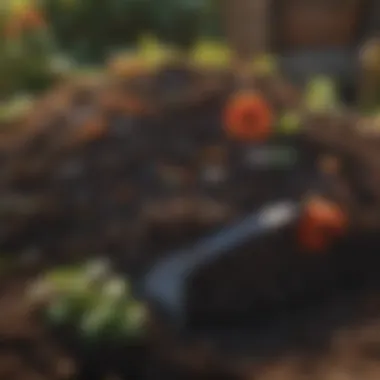

To remedy this, consider the following steps:
- Aerate the pile: Turning the compost can introduce much-needed oxygen, alleviating foul smells.
- Add browns: Incorporating more dry materials can help absorb the excessive moisture that leads to odors.
- Monitor moisture levels: If it feels more like a swamp than a compost pile, draining excess water may be necessary.
Pests can be another unwelcome guests in your composting endeavors. Flies, rodents, and other critters might be drawn to materials that shouldn’t be there—like meat or dairy. To keep pests at bay, focus on these practices:
- Disguise food scraps: Bury them beneath a layer of browns to minimize odors that attract pests.
- Opt for a sealed bin: If you live in an area with a lot of wildlife, consider investing in a compost bin that can be closed tightly.
- Choose your composting method: Some methods like bokashi can effectively limit pest problems.
"A thriving compost pile is like a well-balanced dish; too much of one ingredient can spoil the whole meal."
Identifying Compost that is Too Wet or Too Dry
Living through the highs and lows of composting also includes the struggle to maintain the right moisture content. If your compost is too wet, it can lead to unpleasant odors and a slow breakdown of materials. A drenched compost pile can become a breeding ground for anaerobic bacteria, which thrive in wet and low-oxygen conditions.
To know if your compost is excessively wet, check for:
- Sodden clumps: If your materials form sticky clumps that don’t break apart easily, it’s time for a change.
- Sour smell: An overly moist pile often gives off a foul odor.
To fix overly wet compost, you can:
- Add dry materials: Incorporating browns, like shredded newspaper or dry leaves, can help absorb excess moisture.
- Increase aeration: Turn the pile to uncover some of the wetter materials for better drying.
Conversely, if your compost is too dry, it might not break down effectively. Signs of dry compost include:
- Dusty texture: If your compost looks like crumbled dirt, it needs some water.
- Pale color: Dark, rich compost looks healthy while dry compost appears lifeless.
To remedy dry compost:
- Moisten gradually: Spray water on the pile while turning it to encourage even moisture distribution.
- Know when to cover: If it’s sunny out, consider using a tarp or cover your bin to keep moisture in while allowing for aeration.
By paying attention to these signs and addressing the issues head on, anyone can become adept at troubleshooting common composting problems. A bit of attention can transform this green practice into a satisfying journey for both your garden and the environment.
Using Finished Compost
Utilizing finished compost is the final step in the composting journey, transforming all that hard work into something truly beneficial for your garden. Understanding how to effectively incorporate this nutrient-rich organic matter is not just a bonus; it’s essential. Compost improves soil structure, enhances moisture retention, and supplies valuable micronutrients that can sometimes be lacking in regular soil.
One significant advantage of using finished compost is its ability to boost plant health. Not only does compost provide nutrients, but it also aids in preventing plant diseases. The microorganisms in compost compete with harmful pathogens, acting like a shield. This means healthier plants, which can positively affect everything from their growth rate to your overall garden yield.
There are considerations worth mentioning when you plan to use finished compost. The type of plants you are growing and their specific nutrient needs should align with the properties of your compost. Keep in mind, for example, that compost made from vegetable scraps might offer different benefits than compost made primarily from yard waste.
"The best time to incorporate compost into your garden is in the spring or fall, just before planting or right after harvest to allow nutrients to fuse with the soil."
Incorporating Compost into Your Garden
When you’re ready to dive into your garden with that rich, earthy compost, the next step is to apply it correctly. Sprinkling compost over the top of your garden beds, mixing it into the soil, or using it as a side dressing can all yield impressive results.
One effective method to use finished compost is by top dressing your plants. You can spread a layer of compost about one to two inches thick around plants, then gently work it into the soil surface. Not only does this provide nutrients straight to the roots, it also reduces the need for additional fertilizers, thereby saving you a bit of cash in the long run.
In the case of annual plants, consider mixing compost into the soil before planting. A ratio of one part compost to three parts soil is a good starting point. This can create a nutrient-rich environment that encourages robust root development. For perennials, adding compost directly onto existing soil can help sustain ongoing growth and vitality.
Storage and Application Techniques
Storing finished compost can be as simple as keeping it in a designated bin or pile in a shady area to avoid over-drying. However, the key is to make sure you keep it accessible and dry enough to prevent it from compacting, which can limit its effectiveness when you do decide to apply it.
To apply compost, here are some straightforward techniques to ensure it works its magic efficiently:
- Spread and Mix: After applying, mix the compost into the top few inches of soil. This integrates it seamlessly into your garden.
- Water Well: After adding compost, a good watering can help leach nutrients deeper into the soil where roots can reach them.
- Observe Plant Response: Keep an eye on how plants react after application. You'll want to notice if they seem to thrive or display signs of nutrient deficiency. Adjust your application techniques based on these observations to better meet their needs.
In sum, using finished compost isn’t merely a task; it’s a strategic move in the vast play of garden management. By being diligent with the incorporation and application of compost, you're setting the groundwork for a flourishing garden, one rich in the nutrients necessary to support plant life.
Closure
As we’ve traversed through the various aspects of home composting, it becomes clear that this practice is not only beneficial, but also essential for sustainable living. Composting at home allows you to effectively recycle your organic waste, transforming what was once considered trash into a rich resource for your garden. This cycle of reuse benefits not just your own backyard, but also the environment by reducing landfill waste and lowering greenhouse gas emissions.
The significance of understanding the principles of composting cannot be overlooked. From the initial setup of your composting system to the final application of the nutrient-rich compost in your garden, each step cultivates a deeper connection with nature. By bringing a bit of the outdoors into your own home, you contribute to the health of the ecosystem.
Moreover, the economic upside of home composting is noteworthy. Imagine saving on fertilizers and soil amendments by creating your own compost. It enhances soil health, encouraging a more abundant plant growth, which is particularly crucial for real estate enthusiasts looking to boost property value through landscaping. For those with a penchant for travel or interior design, the knowledge gained through composting can foster a more eco-conscious approach in every aspect of life.
"Composting is nature's way of recycling, reducing waste, and enriching our soil."
Summarizing Key Points on Home Composting
- Home composting transforms organic waste into valuable nutrients for your garden.
- It significantly reduces landfill waste and supports environmental health.
- Understanding composting methods can enhance personal and property value in real estate.
- The practice cultivates a stronger connection to nature and a more sustainable lifestyle.
- Composting reduces the need for chemical fertilizers, promoting healthier soils.
- It's an economical option that pays off over time through reduced garden maintenance costs.
In light of the aforementioned points, embracing composting becomes not just a choice, but a commitment to sustainable practices that align with contemporary desires for ecological responsibility.















